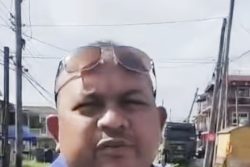Dear Editor,
A recent letter (‘the government continues to commit to Amerindian development’ SN, August 8), written by my parliamentary colleague Norman Whittaker, MP, has caught my attention and is in need of a response. Mr Whittaker, undoubtedly one of the more enthusiastic and well meaning Members of Parliament on the government side, has on this occasion, allowed his exuberance to get the better of him when on commenting on the fact that Indigenous leaders journeyed from far and away to attend the recently concluded National Toshaos Council. He wrote inter alia, “This reflected the trust and confidence they had reposed in the PPP/C government that had over the years, provided increasing opportunities to enhance the livelihood of Indigenous people socially, and economically, in spite of the high costs of delivering social services and improved infrastructure to the villages.
As a result, our government has been able to reduce the huge disparity in terms of access to social services and physical infrastructure that exists between the hinterland, where most of our Amerindian brothers and sisters live, and the rural/urban areas.”
Apart from sounding very propagandistic, these words, and others within the letter, paint a false impression of prosperity that is absent from most of the hinterland communities, and has to be responded to.
No one denies that progress has been made in seventeen years, as we expect that it should be, but relatively speaking, the condition of the average Amerindian remains grim, and his future uncertain. A visitor to any hinterland community will be met with complaints and requests for assistance of many sorts.
Unfortunately, for Mr Whittaker, on the same day that his letter appeared, Stabroek News also carried a story of the travails of passengers on the MV Kimbia who were left stranded on their journey from the North West. These two commentaries, when juxtaposed, create a glaring contradiction between the features of excellent PPP/C governance that my friend Norman was extolling on, and the stark reality of what the residents of Region One have to face on a fortnightly basis.
A passenger on board the distressed MV Kimbia is quoted as saying “It was awful… I don’t know why they are doing the North-West people this.” I, and many others, believe that the state of the MV Kimbia, and other vessels plying the North West route, and the conditions under which North West residents travel, are symbolic of the lack of concern that the government has for the affairs of the people of the hinterland, and that this government places far more emphasis on show than on substance.
It is appalling to know that this government, which claims to care so much for the Amerindian people, could allow the residents of Region One, which has a sizeable section of the Amerindian population resident there, to be subjected to inhumane conditions on board a ferry that has long outlived its usefulness. It is not easy to dismiss the latest mishaps as being random and unexpected. The ferry service to the North West has, for many years, been, and remains a thorny issue for all residents in the region and is the subject of many articles and letters to the press. There has been a lot of talk about roll-on and roll-off ferries servicing the route – gifts from the government and people of China – but I believe that the Minister of Transport should be honest and let the people know what the true status of these gifts is.
So when Mr Whittaker speaks of the coming together of Toshaos from across the country, and boasts that this is unprecedented in any part of the world, he should arm himself with all of the facts because his government is speaking from two mouths. If they really care then they should focus on the things that matter like jobs, opportunities for investment, respect, markets for products and a safe, humane, and reliable means of transporting people and goods from one place to another.
I continue to make the claim that the Ministry of Amerindian Affairs’ orientation is misguided and needs to be realigned and the ministry given the tools and resources to truly represent the interests of Amerindians, rather than just organize cultural events and consultations. I wrote recently that “Little has been done on the economic front in the past 17 years of PPP governance.
We challenge the government to name any new programme or project in any Amerindian community that will bring major development and jobs. A visit into any part of the interior will reveal scores of disgruntled youths who are anxious for employment, and disappointed that they are unable to access birth certificates to give them an identity, and jobs and opportunities that give them a sense of accomplishment and belonging.” What we need is to also focus on development of the economic and social kinds.
In closing, I leave my friend Mr Whittaker to ponder on these few questions; rhetorical as they are, he is free to respond if he so desires:
1. Why are the Toshaos only allowed to interact with the government ministers and officials on their historic coming together?
2. Is the Toshaos Council an extension of the PPP/C government?
3. Were the travel and accommodation of the Toshaos paid for by the PPP/C government, or did they travel under their own steam so to speak?
4. Is the PPP/C government afraid to open the council to views and opinions other than its own?
5. How, in your opinion, were the Toshaos able to “distinguish who are the real leaders of the Amerindian people and separate them from the aspirants and pretenders to leadership,” as you put it, when they were exposed only to, and interacted only with, the President and selected ministers of government?
6. Is leadership of the Amerindians one of the prizes of winning government and to be competed for?
7. Following the convening of the council has the PPP/C been crowned the undisputed leader of the Toshaos?
8. Who are the “aspirants and pretenders to leadership” of the Amerindian people that are referred to?
9. Is the PPP/C government being truly democratic and inclusive when in convening the council, as per the Amerindian Act, it does not ensure that the Toshaos themselves and other members of parliament and national stakeholders meet, greet, interact, and share and exchange views with each other?
10. What other good and cogent reasons could be advanced for hiding and separating members of the Toshaos Council away from other opinions?
The presence of democracy means being able to facilitate and cultivate varying views and opinions so that decisions, when made, are truly free and informed. Indeed isn’t it a right that the Amerindian decision-makers have “free, informed and prior consent” in decisions affecting them, and in the process of making their own decisions?
Holding historic councils by themselves will not advance the welfare of the Amerindians when their sisters and brothers throughout the country suffer for lack of resources, empowerment, jobs, access to technology to develop their farms, access to markets when they do produce, and access to cheap, reliable, safe, and humane means of transportation. The story is the same throughout the hinterland, and no amount of spin, or dressing up, or parading of faces in the newspapers and television will change the facts. They are what they are.
Yours faithfully,
Raphael Trotman









